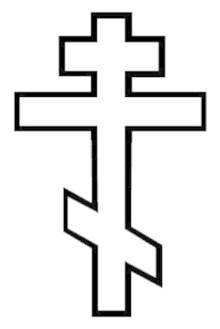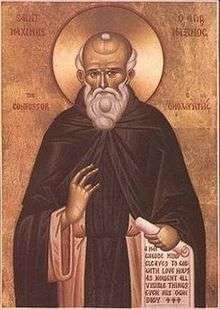December 14 (Eastern Orthodox liturgics)
December 13 - Eastern Orthodox liturgical calendar - December 15
All fixed commemorations below celebrated on December 27 by Eastern Orthodox Churches on the Old Calendar.[note 1]
For December 14th, Orthodox Churches on the Old Calendar commemorate the Saints listed on December 1.
Saints
Pre-Schism Western saints
- Martyrs Justus and Abundius (283)[6][note 3]
- Saint Pompeius of Pavia, Bishop of Pavia in Italy (c. 290)[6]
- Saint Matronian, born in Milan, he became a hermit; his relics were enshrined by St. Ambrose.[6]
- Saint Viator of Bergamo, an early Bishop of Bergamo in Italy from 344 to 378 (378).[6]
- Hieromartyr Nicasius of Rheims, Bishop of Rheims in France, with his sister Eutropia and Companions (407)[6]
- Saints Fingar (Gwinear) and Phiala, brother and sister, and Companions, martyrs in Cornwall (5th century)[6][note 4]
- Saint Agnellus, a hermit and then Abbot of San Gaudioso near Naples in Italy (c. 596).[6][note 5]
- Saint Venantius Fortunatus, Bishop of Poitiers (c. 609)[6][note 6]
- Saint Hibald (Hygbald), an abbot in Lincolnshire in England to whom several churches are dedicated, notably at Hibaldstow (c. 690)[6][note 7]
- Saint Folciunus, Bishop of Tervas (Netherlands) (855)[9]
Post-Schism Orthodox saints
Other commemorations
- Commemoration of the Constantinople earthquake of 557.[14][note 8]
- Repose of Blessed Recluse John of Sezenovo Convent (1839).[9]
Icon gallery
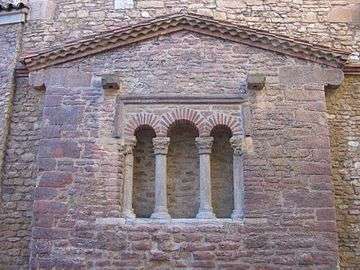
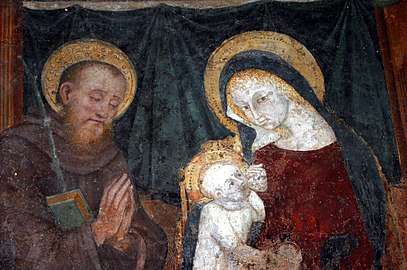 Saint Matronianus, with the Theotokos and Christ.
Saint Matronianus, with the Theotokos and Christ.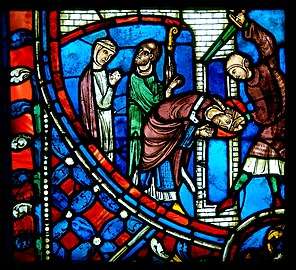 Martyrdom of St. Nicasius of Rheims.
Martyrdom of St. Nicasius of Rheims.- Miniature of St. Venantius Fortunatus.
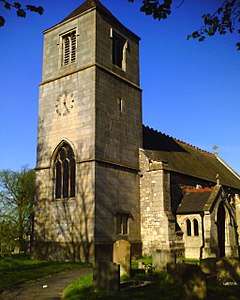 Tower of St Hybald's Church in Hibaldstow.
Tower of St Hybald's Church in Hibaldstow.
Notes
- The notation Old Style or (OS) is sometimes used to indicate a date in the Julian Calendar (which is used by churches on the "Old Calendar").
The notation New Style or (NS), indicates a date in the Revised Julian calendar (which is used by churches on the "New Calendar"). - He is unknown in the Synaxarion of St. Nicodemus and in the printed Menaia. However his memory is preserved in Parisian Codex 1590, along with that of Philemon and Apollo († 14 December).
- Martyrs in Spain under Numerian. After a futile attempt to burn them at the stake, they were beheaded.
- "ST. FINGAR and his sister were children of one of the Kings of Ireland, and were converted to the Faith, it is said, by the preaching of St. Patrick. They were driven into exile by their father's hostility to Christianity, and found their first place of refuge in Brittany, according to the tradition of that province. They were graciously welcomed by Andrew, the prince of the land, and provided with a place for their settlement. After a time, however, they and their companions resolved to establish themselves in Great Britain, either to secure greater solitude, or, as some say, to preach the Gospel to the English, who were then beginning to occupy the country. Their pious intention earned for them the crown of martyrdom, for they had scarcely landed near Hayle, in Cornwall, when they were attacked by Tewdrick, the pagan King of the Damnonians, and put to death in hatred of the Faith. St. Fingar is honoured in the Cathedral of Vannes on the 14th of December, and has given his name to places in that diocese, and in Leon."[7]
- He is one of the patron-saints of the city and was often seen to free the city from its enemies by the power of the cross.
- Born near Treviso in the north of Italy, aged thirty he settled in Poiters in France and was ordained. He became known to Queen St Radegunde who befriended him. He was a writer and poet: the hymns Vexilla Regis and Pange Lingua Gloriosa were composed by him. He became Bishop of Poitiers at the end of the 6th century.
- Stanton lists him on September 18th, as follows:
- "St. Bede relates that HYGBALD was a most holy and mortified man, and Abbot of some place not named in Lindsey, the northern district of Lincolnshire. On one occasion he went over to Ireland and paid a visit to St. Egbert, who was still in his retreat at Rathmelsegi. Their conversation turned on the graces and virtues of St. Chad, who not long before had been taken to a better life, when St. Egbert told his saintly guest, that at the moment of St. Chad's death some one in Ireland, probably meaning himself, had seen the soul of St. Cedd, with a troop of Angels, descend to carry the soul of his brother to the heavenly kingdom. The veneration in which St. Hygbald was held is testified by several churches dedicated in his honour in Lincolnshire."[8]
- This great earthquake, described in the works of Agathias, John Malalas and Theophanes the Confessor, caused great damage to Constantinople, then capital of the Byzantine Empire. According to their accounts, it had a duration of up to ten days.
gollark: It looks so much more readable than standard C.
gollark: VOTE GIBSON!
gollark: no.
gollark: STOP SPLITTINGTHE VOTEVOTE GIBSONAND THEN FORCE HIM TO TRANSFER OWNERSHIP LATER MAYBE
gollark: Praise gibson.
References
- Great Synaxaristes: (in Greek): Οἱ Ἅγιοι Θύρσος, Λεύκιος καὶ Καλλίνικος. 14 Δεκεμβρίου. ΜΕΓΑΣ ΣΥΝΑΞΑΡΙΣΤΗΣ.
- Martyr Thyrsus of Apollonia. OCA - Feasts and Saints.
- Great Synaxaristes: (in Greek): Οἱ Ἅγιοι Φιλήμων, Ἀπολλώνιος, Ἀρριανὸς καὶ οἱ τέσσερις Προτεκτοράτοι. 14 Δεκεμβρίου. ΜΕΓΑΣ ΣΥΝΑΞΑΡΙΣΤΗΣ.
- Martyr Apollonius of Alexandria. OCA - Feasts and Saints.
- Great Synaxaristes: (in Greek): Ὁ Ἅγιος Ὑπάτιος ὁ Μάρτυρας καὶ οἱ σὺν αὐτῷ 36 μαρτυρήσαντες. 14 Δεκεμβρίου. ΜΕΓΑΣ ΣΥΝΑΞΑΡΙΣΤΗΣ.
- December 14. Latin Saints of the Orthodox Patriarchate of Rome.
- Rev. Richard Stanton. A Menology of England and Wales, or, Brief Memorials of the Ancient British and English Saints Arranged According to the Calendar, Together with the Martyrs of the 16th and 17th Centuries. London: Burns & Oates, 1892. p.600.
- Rev. Richard Stanton. A Menology of England and Wales, or, Brief Memorials of the Ancient British and English Saints Arranged According to the Calendar, Together with the Martyrs of the 16th and 17th Centuries. London: Burns & Oates, 1892. pp. 451-452.
- December 14/27. Orthodox Calendar (PRAVOSLAVIE.RU).
- St Hilarion, Metropolitan of Suzdal and Yuriev. OCA - Feasts and Saints.
- December 27 / December 14. HOLY TRINITY RUSSIAN ORTHODOX CHURCH (A parish of the Patriarchate of Moscow).
- The Autonomous Orthodox Metropolia of Western Europe and the Americas (ROCOR). St. Hilarion Calendar of Saints for the year of our Lord 2004. St. Hilarion Press (Austin, TX). p.93.
- (in Russian) 14 декабря (ст.ст.) 27 декабря 2013 (нов. ст.). Русская Православная Церковь Отдел внешних церковных связей. (DECR).
- Great Synaxaristes: (in Greek): Μνήμη φοβερῆς ἀπειλῆς σεισμοῦ. 14 Δεκεμβρίου. ΜΕΓΑΣ ΣΥΝΑΞΑΡΙΣΤΗΣ.
Sources
- December 14/27. Orthodox Calendar (PRAVOSLAVIE.RU).
- December 27 / December 14. HOLY TRINITY RUSSIAN ORTHODOX CHURCH (A parish of the Patriarchate of Moscow).
- December 14. OCA - The Lives of the Saints.
- The Autonomous Orthodox Metropolia of Western Europe and the Americas (ROCOR). St. Hilarion Calendar of Saints for the year of our Lord 2004. St. Hilarion Press (Austin, TX). p. 93.
- December 14. Latin Saints of the Orthodox Patriarchate of Rome.
- The Roman Martyrology. Transl. by the Archbishop of Baltimore. Last Edition, According to the Copy Printed at Rome in 1914. Revised Edition, with the Imprimatur of His Eminence Cardinal Gibbons. Baltimore: John Murphy Company, 1916.
Greek Sources
- Great Synaxaristes: (in Greek) 14 ΔΕΚΕΜΒΡΙΟΥ. ΜΕΓΑΣ ΣΥΝΑΞΑΡΙΣΤΗΣ.
- (in Greek) Συναξαριστής. 14 Δεκεμβρίου. ECCLESIA.GR. (H ΕΚΚΛΗΣΙΑ ΤΗΣ ΕΛΛΑΔΟΣ).
Russian Sources
- (in Russian) 27 декабря (14 декабря). Православная Энциклопедия под редакцией Патриарха Московского и всея Руси Кирилла (электронная версия). (Orthodox Encyclopedia - Pravenc.ru).
- (in Russian) 14 декабря (ст.ст.) 27 декабря 2013 (нов. ст.). Русская Православная Церковь Отдел внешних церковных связей. (DECR).
This article is issued from Wikipedia. The text is licensed under Creative Commons - Attribution - Sharealike. Additional terms may apply for the media files.
